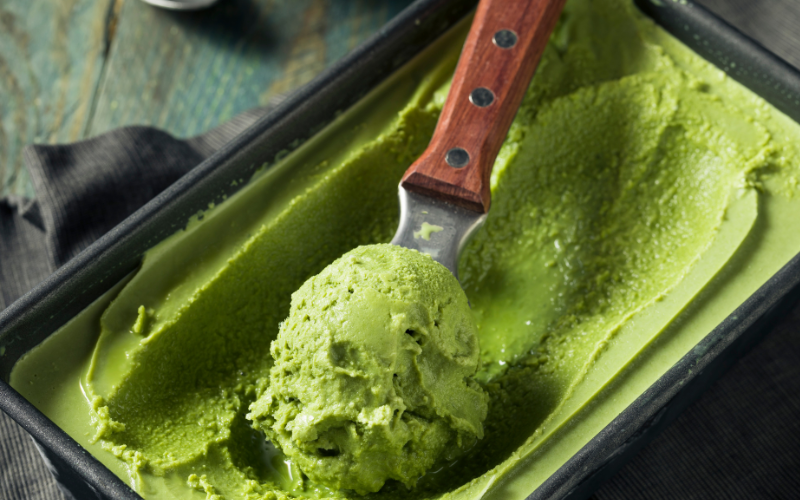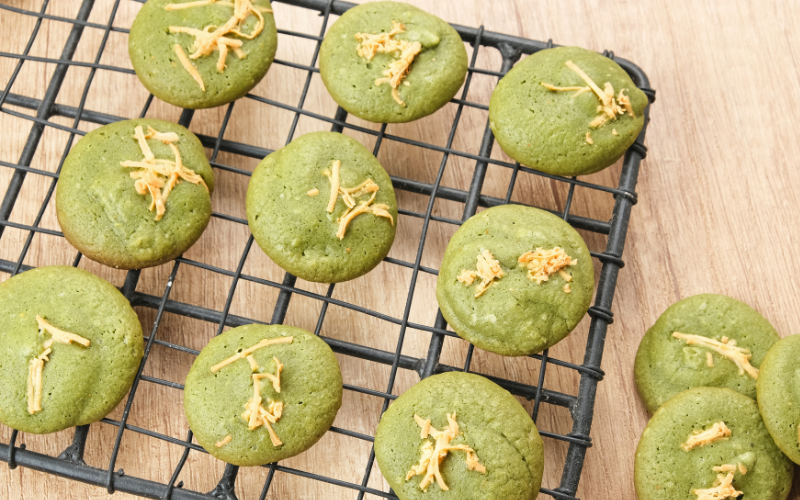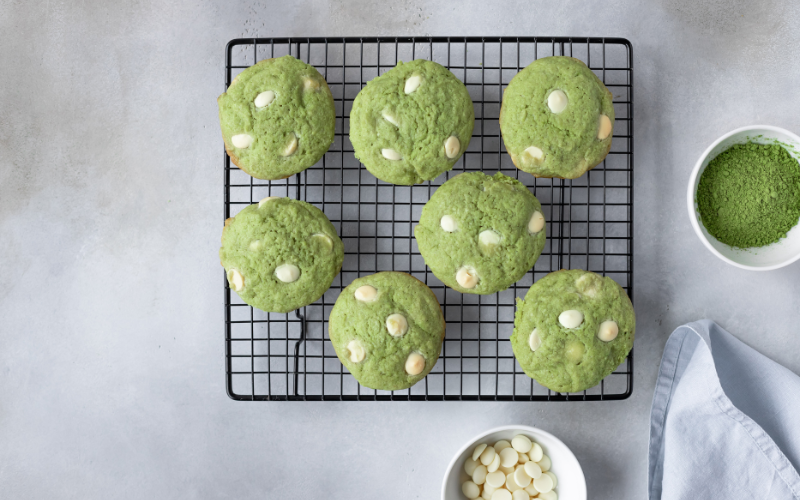matcha:
Aesthetic and Functional Ingredient for Food Manufacturers
Matcha, the vibrant green tea powder from Japan, is more than just a drink; it is a versatile and aesthetically pleasing ingredient that has captivated food manufacturers worldwide. With its rich flavor profile, health benefits, and vibrant green color, matcha has found its way into a variety of products, ranging from traditional beverages to innovative desserts. Here, we explore matcha’s history, applications, benefits, and provide a delectable recipe for Matcha Black Sesame Cookies.
St. Charles Trading is the nation’s premier Global Supply Chain Solutions provider, specializing in food ingredient distribution. We will be the secret ingredient you will want to tell everyone about. Contact Us to Learn More.
History and Origin of Matcha

Matcha’s roots trace back over a thousand years to China during the Tang Dynasty, where tea leaves were steamed and formed into bricks for storage and trade. The method of grinding tea leaves into powder was later adopted by Japanese monks in the 12th century, who brought it to Japan for use in Zen meditation practices. Over time, matcha evolved into a cornerstone of Japanese tea culture, particularly during the Ashikaga and Momoyama periods, when the formal tea ceremony, or “chanoyu,” flourished under the influence of tea masters like Sen no Rikyū.
In Japan, matcha became more than just a beverage; it symbolized mindfulness, tranquility, and aesthetic appreciation. The cultivation process of shade-growing tea plants, known as “tencha,” to produce matcha powder reflects this dedication to quality and tradition. This meticulous method enhances the tea’s umami flavor and preserves its vibrant green color, making matcha a revered ingredient in both historical and modern contexts.
The aesthetic appeal of matcha
Matcha’s vibrant green color is one of its most defining features, making it a favorite among food manufacturers aiming to create visually stunning products. Its bright, natural hue conveys freshness, health, and sophistication, elevating the presentation of beverages like lattes, iced teas, and frappes. In desserts such as roll cakes, crinkle cookies, and ice cream, matcha’s color serves as both a decorative and thematic element, instantly drawing consumer attention.
The versatility of matcha allows it to complement various aesthetics, from minimalist designs to intricate confections. The striking contrast of its green color against other ingredients—such as the black sesame in cookies or the white chocolate in brownies—creates a visually appealing harmony. Beyond its appearance, matcha’s fine powder texture also enables precision in food preparation, ensuring that its vibrant color and flavor are evenly distributed in recipes, adding to its allure.
Matcha’s Flavor Profile
Matcha boasts a complex flavor profile that balances earthy bitterness with subtle sweetness. This makes it a versatile ingredient for a wide array of recipes, from brownies and crinkle cookies to smoothies and frappes. Matcha’s umami flavor complements ingredients like black sesame, white chocolate, and strawberry, enhancing the taste of various desserts and drinks.
Health Benefits of Matcha
One of the biggest draws of matcha is its extensive health benefits. Packed with antioxidants, matcha supports overall wellness, boosts metabolism, and improves focus, making it a popular choice among health-conscious consumers. Matcha’s caffeine content is noteworthy, offering a steady energy boost without the jitters often associated with coffee. Its half-life provides sustained energy, making it ideal for those who seek calm alertness during meditation or busy workdays.
Matcha vs. Coffee and Green Tea
Compared to coffee, matcha provides a smoother caffeine experience, while offering additional health benefits like improved metabolism and antioxidant support. Unlike traditional green tea, matcha contains the entire leaf, resulting in higher nutrient and antioxidant levels. When comparing their benefits, matcha stands out as a superior choice for nutrition and flavor.
Applications of Matcha in Food Manufacturing
Matcha’s versatility makes it a sought-after ingredient for food manufacturers. Here are some popular applications:
Beverages
Matcha is a star ingredient in drinks such as bubble tea, iced lattes, hot chocolate, and martinis. Its vibrant color and distinct taste elevate frappes, smoothies, lemonade, and even drink recipes like matcha affogato.
Baked Goods
Matcha enhances a variety of baked goods, from amaretti cookies and shortbread to checkerboard cookies and roll cakes. Its earthy flavor pairs beautifully with sweet and creamy ingredients like white chocolate and jam.
Desserts
Food manufacturers are incorporating matcha into ice cream recipes, tiramisu, mochi, and even Kit Kat bars. Its versatility extends to oatmeal and overnight oats recipes, providing a nutrient-rich breakfast option.
Snacks
Products like matcha-flavored Pocky and matcha donuts are gaining popularity for their unique flavor and health appeal. Even quick breads and pancakes can benefit from a matcha-infused twist.
Specialty Products
Matcha’s growing demand has led to innovative products like matcha k-cups for Keurig machines, matcha jelly, and matcha-infused yogurt recipes. These products cater to both health-conscious consumers and those seeking indulgent treats.
Nutrition Facts and Green Tea Benefits
Matcha is rich in catechins, a type of antioxidant linked to improved heart health and reduced inflammation. It also provides L-theanine, an amino acid that promotes relaxation and focus. Organic matcha offers additional benefits by being free of synthetic pesticides and fertilizers.
Tools for Using Matcha
To prepare matcha, tools like a bowl and whisk or a frother are essential for achieving a smooth and frothy texture. These tools are equally important for food manufacturers creating matcha-based beverages or desserts.



Matcha Black Sesame Cookies Recipe
This recipe combines the earthy flavors of matcha and black sesame for a delightful cookie that is perfect for any occasion.
Ingredients:
1 cup all-purpose flour
1 tbsp matcha powder
1/2 tsp baking powder
1/4 tsp salt
1/2 cup unsalted butter, softened
1/2 cup granulated sugar
1 large egg
2 tbsp black sesame seeds
1/2 tsp vanilla extract
Instructions:
Preheat the oven to 350°F (175°C). Line a baking sheet with parchment paper.
Combine dry ingredients: In a bowl, whisk together the flour, matcha powder, baking powder, and salt.
Cream butter and sugar: In a separate bowl, cream the butter and sugar until light and fluffy. Beat in the egg and vanilla extract.
Mix the dough: Gradually add the dry ingredients to the wet ingredients, mixing until just combined. Fold in the black sesame seeds.
Shape cookies: Scoop tablespoon-sized portions of dough and roll them into balls. Place them on the prepared baking sheet and slightly flatten each ball.
Bake: Bake for 10-12 minutes or until the edges are lightly golden. Let the cookies cool on the baking sheet for 5 minutes before transferring to a wire rack to cool completely.
Conclusion
Matcha’s combination of aesthetic appeal, unique flavor, and health benefits make it an essential ingredient for food manufacturers. Whether used in cookies, cakes, drinks, or specialty snacks, matcha continues to delight consumers around the world. By incorporating matcha into your product lineup, you can offer a distinctive and health-conscious option that stands out in the market.
Ready to talk?
Are you looking for spec sheets, samples or prices? We would love to chat about how we can help.